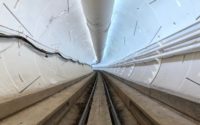Predicting Amtrak’s Return to Indio
Indio has earned a national status as the “The City of Festivals”, drawing nearly 1.4 million annually to events such as Coachella and Stagecoach. Moreover, Indio’s City Council unanimously passed a measure in 2016 to raise the attendance cap on both of these festivals by nearly 62,000. These festivals have brought money and business to the city, and to encourage continued turnout, construction is underway for a train platform at the city’s transit center, which will provide festival-goers with the opportunity to transport themselves to the city’s concerts via Amtrak. The station is expected to be open in the spring of 2020 in time for the season’s major music festivals.
The station is likely to be a major hit among out-of-state festival-goers because it will potentially save attendees hundreds in rental car and ridesharing fees. Although the Indio station will only operate for special events such as Coachella, the city has expressed a long-term goal of bringing back a full-service train station. Amtrak halted regular service to Indio in 1998.
With Indio’s population of nearly 90,000 being one of the fastest-growing cities in the Coachella Valley, it is worth investigating whether a fully operational station would be in Amtrak’s best interest. The federally subsidized company has not generated a profit for decades and has hinted at cutting costs by reducing service to some long-haul routes including the Sunset Limited, the line that runs through Indio. Amtrak needs assurance that Indio’s station would attract enough short-haul intercity ridership, which the company’s CEO Richard Anderson explained is the company’s primary strategy to increase revenue.
To answer whether a fully operational train station in Indio would fulfill the Amtrak’s criteria, the Lowe Institute has generated an estimate of demand using data from existing Amtrak stations. We gathered data from the National Association of Rail Passengers database on annual ridership across California’s 79 railway stations as well as data from the Census Bureau on where workers are employed to develop a model that could predict annual ridership for a fully operational station in Indio.
The graph depicts projected ridership based on California’s 65 current Amtrak stations. We first calculated the number of people that commuted from the city in which the station was located to other cities along the Amtrak line. These are the potential commuters. We then compared actual Amtrak ridership from that station to these potential commuters from that station. This simple relationship explains 42% of the variation in ridership across stations, delivering a quick yet informative estimate. Projecting this relationship to the new station predicts annual ridership for Indio of 94,226.
Besides the Lowe’s prediction on annual ridership for Indio’s station, it’s worth addressing the changing employment demographics of Indio. Once again drawing from data from the Census Bureau, the number of Indio residents who are employed in Californian cities with stations on the Sunset Limited Line has increased at an 8.2% average annual rate since 2009, when Indio experienced its highest unemployment rate, to the most recent measurement in 2017. As of 2017, there are 2,546 Indio residents employed in the four Californian cities with stations on the Sunset Limited Line. On the other hand, the number of workers that are employed in Indio but reside in one of the four cities has declined at an average annual rate of -2.6% from 2009 to 2017. However, this number is much lower with only 606 workers commuting to Indio.
Should Amtrak choose to fully service a station in Indio it should bet on these employment numbers for Indio residents working outside the city to continue to rise at a steady pace and the decline in the number of non-residents working in Indio to reverse its current trend.
It’s important to acknowledge other factors that could contribute to long-term changes in train ridership for a station in Indio. Factors include changes in industry and demographics. The city is in the process of implementing a 2040 general plan to strengthen its tourism and hospitality sector that would encourage more people to visit the city year-round. A train system would allow for more convenient access to the city’s amenities because outside residents could avoid the burden of traveling through Southern California traffic. Additionally, Indio is expanding its housing options, which could allow more people to live in Indio and commute to neighboring cities on the Sunset Limited Line; Indio’s housing prices are on average much cheaper than its western counterparts.
Indio has become a powerhouse in the Coachella Valley. Adding a permanent Amtrak station would contribute to its growing role in Southern California.


